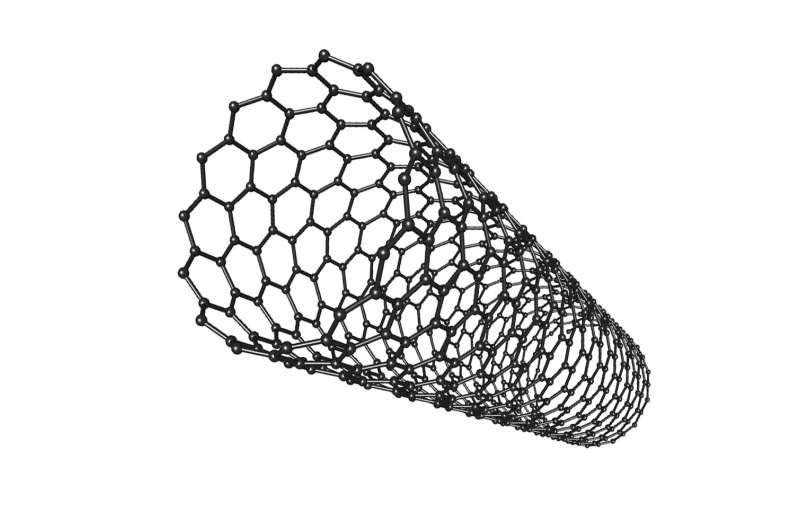September 8, 2016 report
Research team finds a way to accurately measure permeability of carbon nanotubes

(Phys.org)—A team of researchers with PSL Research University in France and Brown University in the U.S. has found a way to accurately measure the permeability of carbon nanotubes. They have published an outline of their technique in the journal Nature. Angelos Michaelides with University College London offers a News & Views paper outlining the work done by the team in the same journal issue.
Scientists working in various fields have been hard at work studying carbon nanotubes for several years now because of the material's unique and useful properties, one of which is low friction. This particular attribute has come to the attention of engineers and other researchers working on improving desalination devices—less friction in such a device would make it more efficient. But because nanotubes are so small it has been difficult to measure how quickly water is able to move through them—thus far, test results have varied so widely that none can be taken as accurate. In this new effort, the researchers have come up with a technique that is accurate and reliable, suggesting the problem has finally been solved.
Realizing that measuring a liquid moving through a nanotube was not really feasible, at least for now, the researchers instead developed a device that measured the displacement of polystyrene nanoparticles that were large enough to be seen. The device consisted of two small wells containing water that were connected by a single nanotube. The nanoparticles were suspended in the well into which the water would flow as it was ejected by the nanotube. To make the device work, the researchers increased the pressure of the water on the feed side, forcing an extremely tiny stream to be pushed through the nanotube and into the other well. By measuring the displacement of the particles in the output well as the water rushed out, the researchers were able to very accurately measure the rate at which the water moved through the nanotube, and thus the degree of friction involved.
As part of their experiments, the researches tried using nanotubes with different sized radii and discovered that the thinnest nanotubes demonstrated nearly zero friction. In sharp contrast, they found that nanotubes made of boron nitride (which some have suggested might be just as good as carbon nanotubes) were not nearly as slippery.
More information: Eleonora Secchi et al. Massive radius-dependent flow slippage in carbon nanotubes, Nature (2016). DOI: 10.1038/nature19315
Abstract
Measurements and simulations have found that water moves through carbon nanotubes at exceptionally high rates owing to nearly frictionless interfaces. These observations have stimulated interest in nanotube-based membranes for applications including desalination, nano-filtration and energy harvesting, yet the exact mechanisms of water transport inside the nanotubes and at the water–carbon interface continue to be debated because existing theories do not provide a satisfactory explanation for the limited number of experimental results available so far. This lack of experimental results arises because, even though controlled and systematic studies have explored transport through individual nanotubes, none has met the considerable technical challenge of unambiguously measuring the permeability of a single nanotube. Here we show that the pressure-driven flow rate through individual nanotubes can be determined with unprecedented sensitivity and without dyes from the hydrodynamics of water jets as they emerge from single nanotubes into a surrounding fluid. Our measurements reveal unexpectedly large and radius-dependent surface slippage in carbon nanotubes, and no slippage in boron nitride nanotubes that are crystallographically similar to carbon nanotubes, but electronically different. This pronounced contrast between the two systems must originate from subtle differences in the atomic-scale details of their solid–liquid interfaces, illustrating that nanofluidics is the frontier at which the continuum picture of fluid mechanics meets the atomic nature of matter.
Journal information: Nature
© 2016 Phys.org





















